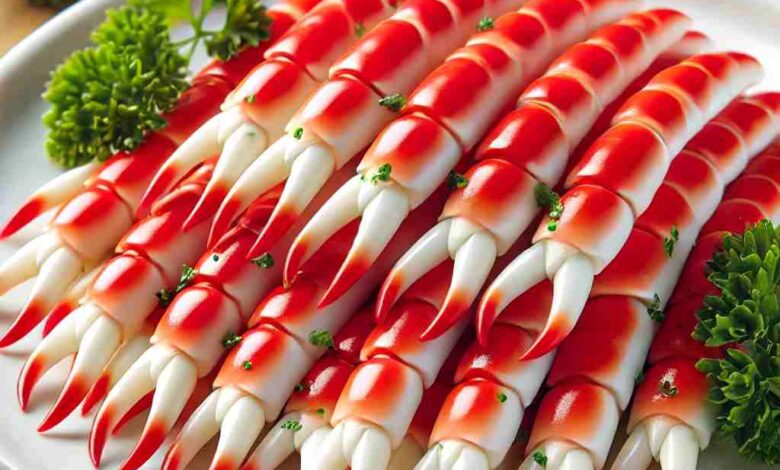Exploring Kanikama: The Versatile Staple in Japanese Cuisine

When it comes to Japanese food, kanikama—imitation crab—is a versatile and inexpensive ingredient. A popular substitute for crab meat, found in many sushi rolls and salads, that replicates the flavor and texture of real crab is kanikama. The truth is, surimi (a paste of minced white fish) may form the base, but from that humble starting point comes kanikama. While it might not resemble its namesake in origin, people worldwide enjoy this affordable crab-like substance.
Origin
Kanikama originated in Japan in 1974, first produced by Sugiyo Co., Ltd. Introduced as flake-like panels, the crab stick evolved into its current form. This change was notably led by Osaki Suisan Co., Ltd., in 1975, who made crab sticks the shape we know today. The innovation provided a cheaper alternative to real crab meat, serving both domestic and export markets. Kanikama gained popularity in the 1980s, especially in the United States, which produces and exports about one-third of imitation crab.
Composition and Production
Surimi is the main ingredient of this, which consists of minced white fish (usually pollock or hake) with additives such as starch, egg whites, and flavorings like crab extract or monosodium glutamate (MSG). After the mixture is shaped into sticks and steamed, it results in a product that closely resembles crab meat in both appearance and taste. A recognizable red stripe is then often added to make it look more like crab legs.
Nutritional Profile
Kanikama is a cheap, convenient crab substitute but lacks some nutritional benefits of real crab meat. It is high in sodium but low in calories and fat. A typical 3-ounce serving provides 43 calories and less than 10 grams of carbs, with more than half your daily recommended intake for sodium, approximately totaling about 715 milligrams per portion. Due to its high sodium content, people who are limiting their salt intake should consume kanikama cautiously.
Culinary Uses
Sushi and Sashimi
This is mostly consumed in sushi, as a part of popular rolls such as in California and Alaska. The flavor of the sushi rice is seasoned, so its mild and sweet taste goes well with everything else. For nigiri sushi, this is placed on top of an oblong-shaped mound with no layers added. The two ingredients are bound together in most cases by the use of a strip or threading through the center using nori strips.
Salads and Appetizers
This is also used as a salad and appetizer. Finally, there is also a hugely popular hot kani salad which really heats things up by combining shredded kanikama with cucumber and carrot slices within a mayonnaise-based dressing amped-up to heat scale. The combination of sweet and mild kanikama, fresh vegetables, and creamy dressing is perfect for a refreshing but tasty salad.
Cooking and Other Dishes
More than sushi and salad, kanikama can be used in various cooked dishes. Use it in soups, stews, and hot pots, or as a sandwich/wrap filling. Kanikama is ready to eat, it can also be recognized by this feature and enjoyed straight from the fridge or slightly warmed only; excessive cooking makes its structure less juicy.
Kanikama vs. Real Crab Meat
While kanikama is an easy alternative, it still has some notable differences from real crab meat. It has a fuller, more pronounced (slightly nutty/briny) taste and texture; kanikama is bleached white from processing so it always tastes the same no matter what kind of crab was used. Crab sticks are very affordable and seem like a crab, but actually there is no real meat in that real-like stick.
Storing and Handling Kanikama
Great kanikamas are shelf-steady until ready for consumption. It stays fresh in the fridge and can be frozen for months without losing flavor or texture. The kanikama should be eaten within a few days after opening it so that they are retained their freshness. Add kanikama at the end of cooking because its soft texture and gentle flavor don’t hold up well in sauce or curry.
Innovative Culinary Applications
Besides being valuable as imitation seafood, the food service industry has found several innovations in to use kanikama. Using kanikama as Beyond common sushi and salads, chefs are experimenting with the ingredient in a variety of international cuisines. Such as kanikama in Italian pasta food of Mexico tacos to even put on the pizza slice. Its neutral taste and versatile texture suit many flavors, making it ideal for fusion dishes.
This is included in festival foods and street snacks of Japan with so many similar forms, both traditional to innovative showcasing their diversity as well as cultural importance With global tempura to takoyaki (octopus balls), kanikama dishes out an audacious, affordable take on the ordinary and inventive.
Popular Recipes Featuring Kanikama
California Roll
The California Roll, one of the most famous and loved sushi rolls that appears almost everywhere contains kanikama as well. A full roll of this kind normally consists of this, avocado, cucumber, and sushi rice seasoned with furin. Kanikama’s mild sweetness pairs perfectly with creamy avocado and crispy cucumber in this roll.
Spicy Kani Salad
A refreshing salad of shredded kanikama and julienned cucumbers, and carrots in a spicy mayonnaise dressing. Kanikama’s sweetness pairs perfectly with vinaigrette, making it a great starter or side for Japanese dishes.
Kanikama Tempura
Kanikama can be battered with tempura batter and deep-fried until crispy. This Tempura with a side of dipping sauce will give you the best crunch to enjoy this ingredient in.
Tips for Cooking and Storing
To ensure that you get the best out of this, it is very important to store and handle them in an appropriate way. Here are some tips:
Avoid Overcooking: This is fully cooked during production, so it only needs to be warmed slightly if used in cooked dishes. Overcooking can lead to a loss of texture and flavor.
Proper Storage: Keep kanikama refrigerated and consume it within a few days after opening. It can also be frozen for longer storage, making it a convenient ingredient to have on hand.
Versatile Uses: Use kanikama in cold dishes like salads or sushi, or add it to hot dishes at the last minute to preserve its texture.




